Somehow Portugal also seems to be one of the countries overpowered by centralism. Everyone is flocking to the capital Lisbon, which is groaning under the masses of tourists and has to be careful to remain livable for the locals.
Hence, while others are stressed out, Porto pours herself a glass of amber-colored port wine and relaxes as she gazes down the Douro River.
Instead of overwhelming her visitors with innumerable presumably must-see landmarks, Porto invites her guests to take a relaxed stroll down picturesque streets and alleys and offers them a creamy Galão in one of the many charming cafés. The city impresses with cool street art and delights the eye with gorgeous church façades covered in exquisite Azulejos and what is probably the most famous bookstore in the world.
By now, you’ve probably noticed: Porto is one of my favorite cities in Europe and I’m excited to show you the best the city on the Atlantic coast has to offer – also if, just like me, you travel solo.

Bem Vindo ao Porto – Welcome to Porto
Porto, whose name literally translates to harbor in English, is located on Portugal’s Atlantic coast on the northern bank of the Douro River. Together with the city of Vila Nova de Gaia on the opposite side of the river, Porto forms the center of the metropolitan region of the same name.

Since the Roman occupation, Porto has been important primarily as a trading and port city. In the era of European expansion, it evolved into one of the continent’s most important trading metropolises. Although this significance declined with the downfall of the Portuguese colonial empire, Porto remains the economic and industrial center of Portugal to this date. The city is known for its textile, leather goods, metal, as well as chemical industries and an oil refinery. With its university, art academy, museums, theaters, and opera, this second-largest agglomeration after Lisbon also plays a significant role as a cultural and scientific center in Portugal.

Obviously, Porto is also the namesake and place of origin of the world-famous port wine.
In 1996, UNESCO listed the historic city center on the northern bank of the Douro as a World Heritage Site.
The Inexplicable
Since my first, somewhat coincidental visit, Porto has been one of my favorite cities in Europe. I can’t even list tourist superlatives like the Colosseum, the Louvre, or the Tivoli. No, it’s simply the charm of the cobblestone-covered, steep streets that ascend from the banks of the Douro to form the terrace-like structure of the old town of Ribeira. Porto is also known as the Baroque City because of its many baroque churches, many of which the city owes to the Italian-born architect Nicolau Nasoni.

But it’s not just that. Porto has a very special flair. It cannot be explained and is difficult to put into words.
Is this description not enough for you?
Then you probably have to travel to Porto yourself as quickly as possible to experience it with all your senses.
Then, you’ll understand what I mean.
Getting the Blues: Porto’s Sublime Azulejos
An Azulejo is a picture made of mostly square, blue-painted, and glazed ceramic tiles. Although one might think that it got its name from the color blue, which is called azul in Spanish as well as in Portuguese, this is not correct. Rather, the name is derived from the Arabic az-zulaiǧ, translated as tile work. The glazing techniques are a legacy of the Moors, who dominated large parts of the Iberian Peninsula from the 8th century onwards. The manufacturing technique was then adopted by local craftsmen. The tiles are an integral part of the cityscapes and are assembled into fabulous mosaics on house façades and churches.
Estação Ferroviária de São Bento
The first time I came to Porto, I got off at São Bento station and immediately saw probably the best the city had to offer: the entrance hall tiled with antique, painted Azulejos depicting scenes from the city’s glorious past.
Honestly, that hall was all it took to convince me that I had come to a fantastical place!
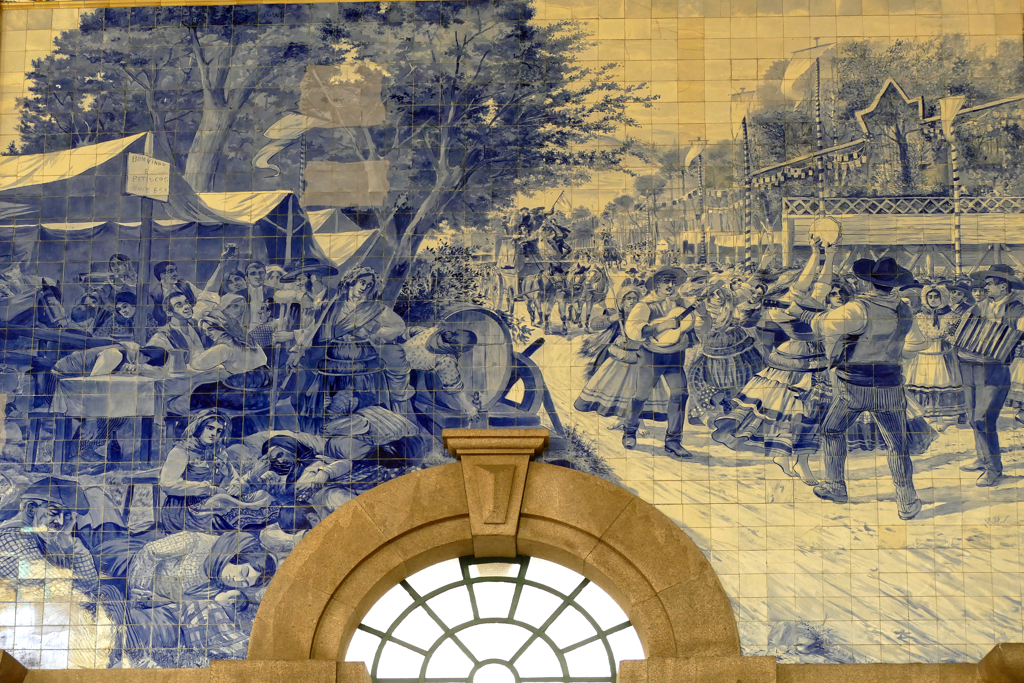
In fact, the São Bento Station is one of Porto’s most famous landmarks and I recommend it as a starting point for a city tour for several reasons. Although the train station is not the most important hub in the city, it is by far the most beautiful!

Porto’s São Bento Station is a true gem that combines history, art, and architecture into a breathtaking experience. The building was built on the site of the former monastery Mosteiro de São Bento de Avé-Maria, hence the name. The first trains ran to São Bento as early as 1896, but the building, based on plans by the architect José Marques da Silva, was only completed in 1916.


Located in the very heart of the city, this train station is famous not only for its role as a transport hub, but above all for the stunning Azulejos that adorn its large entrance hall. Over 20,000 blue and white tiles, masterfully crafted by artist Jorge Colaço, depict key moments from Portugal’s history. Above this, multi-colored panels show rural scenes from different regions.
In fact, the station seems more like a museum than a mere hub.
Igreja de Santo António dos Congregados
As I said, Azulejos are an integral part of Portuguese architecture and I would argue that nowhere are there as many stunningly beautiful façades as in my beloved Porto.
As soon as you have recovered from the breathtaking sight of the São Bento arrival hall and step onto the street, you see on your right the church Igreja de Santo António dos Congregados. It was built in 1703. In the chapel of the Sagrada Familia is the mummified body of Pope Saint Clement. In fact, he’s the only Pope who does not rest in the Vatican.
And obviously, the façade is covered with magnificent images in blue and white, also created by Jorge Colaço.

On my first visit to Porto, I couldn’t really see the façade because there was scaffolding surrounding the church.
The scaffolding’s gone.
But now, the street in front of it has been torn up because the city is building a seventh metro line.
That’s how it is with Porto: Something is constantly being supported, restored, renovated, repaired. The skyline consists of at least as many cranes as church towers. It seems to be a permanent race against time. At first, it shocked me, but now I consider it part of this wonderful city.
Igreja Paroquial de Santo Ildefonso
While we’re at it: On the east side of the São Bento Station is one of my favorite churches in Porto, the Igreja Paroquial de Santo Ildefonso. At the moment, it is also flanked by construction cranes, but you should still pay it a visit.

Before the church was built, a chapel known as Santo Alifon stood on the same site. Due to its deteriorating condition, it was demolished in 1709. Construction of the new church began that same year and it took them 30 years to complete it.


The church is made mainly of granite and has an elongated octagonal design. Its granite façade is simple yet elegant, with two bell towers flanking a central niche that houses a statue of Saint Ildefonso. Among the church’s highlights are the magnificent Azulejos, obviously. They were crafted by no other than Jorge Colaço and added in 1932. The images depict scenes from the life of Saint Ildefonso as well as imagery from the Gospels.
Hence, the Church of Saint Ildefonso is an architectural and artistic treasure.
Igreja do Carmo
And the beat goes on: One kilometer west of the São Bento station at the Praça de Gomes Teixeira stands the impressive Igreja do Carmo. This house of worship was completed in 1768 in the Baroque as well as the Rococo style.

It was built on land adjacent to the Church of the Carmelites. As the construction of two churches together was not permitted at that time, the so-called Casa Escondida, hence, the hidden house, was put between them. Only one and a half meters wide, it is the narrowest house in Porto yet separates the two churches as it’s meant to be.

The Igreja do Carmo’s side facade is embellished with a grand tile panel, representing scenes alluding to the founding of the Carmelite Order. The images were designed by Silvestre Silvestri and painted by Carlos Branco.
Igreja Paroquial de São Nicolau
Initially held in a small 13th-century hermitage, religious services in the parish of São Nicolau needed a larger space. Thus, the hermitage was demolished to make way for the Church of Saint Nicholas in 1671.

However, the church suffered a fire in 1758. Its reconstruction was completed in a mixed neoclassical and baroque style in 1762.
The tiles on the facade were added only in 1861.
Out of the Blue: The Most Iconic Buildings
So there you have it – Porto’s Azulejos-covered structures will make your head spin. Yet, the city will keep amazing you with outstanding buildings and a whole kaleidoscope of different colors, too. Just opposite the Igreja Paroquial de São Nicolau, for instance, is one of the most impressive buildings in the city, namely the Palácio da Bolsa, the old stock exchange.
Palácio da Bolsa
After its construction in the 19th century, the Palácio da Bolsa was used as a stock exchange and commercial court.

The building was constructed on the site of a former Franciscan monastery. In 1841, Queen Maria II donated the ruins of the monastery to the city’s Chamber of Commerce. Construction work began in 1842 according to the plans of the architect Joaquim Porto da Costa Lima Junior. While the core of the building was completed in 1850, the decoration of the interior was not finished until 1910.

Spoiler alert: Goncalves de Soursa designed the so-called Moorish Hall, which was completed in 1879, inspired by the Alhambra in Granada.

Today the Palácio da Bolsa, built in the neoclassical style, is used as a conference center. The building can be visited outside of meeting times, which I highly recommend!

For an entrance fee of 12 €uros, you can visit the Palácio da Bolsa every day from 9 a.m. to 6.30 p.m. on a guided tour in different languages. The tour takes about half an hour.
Igreja Monumento de São Francisco
Around the corner from the Palácio is the incredibly beautiful Igreja Monumento de São Francisco, the most prominent Gothic monument in all of Porto. And indeed, this church is an absolute masterpiece! Construction started in a striking Gothic style in 1383. In the 17th and 18th centuries, it underwent its jaw-dropping transformation into the Baroque style. We’re talking some of the most extravagant, gold-covered decorations you’ve ever seen! It’s pure radiant splendor and one of the crowning achievements of Portuguese talha dourada. Then, perched on the side wall of the rear gallery, there’s this incredible Iberian baroque organ with horizontal reeds!

(Photo: Alegna13, Igreja de São Francisco 01, cropped 3:2, CC BY-SA 3.0)
Under the Igreja de São Francisco lie the catacombs, where the Franciscan monks as well as members of Porto’s wealthiest families are resting. The catacombs also house an ossuary with thousands of human bones which you can see through a glass floor.

(Photo:xiquinhosilva from Cacau, 87371-Porto (49052475727), CC BY 2.0)
The Igreja Monumento de São Francisco can be visited from April to September every day from 9 a.m. to 8 p.m. Between October and March, they are already closing at 7 p.m. The general entrance fee is 8 €uros.
Livraria Lello
Considered one of the most beautiful and famous bookstores in the world, Livraria Lello’s dates back to 1869 when the publisher and bookseller José Pinto de Sousa Lello opened the bookstore. In 1906, the store moved to the iconic building designed by architects Xavier Esteves and Francisco Xavier dos Santos in a neo-Gothic style with Art Nouveau elements.
The heart of the bookstore is the central wooden staircase.

(Photo: Ivo Rainha / Livraria Lello)
During the 20th century, the Livraria Lello played an important role in Porto’s cultural life, becoming a meeting place for intellectuals, writers, and artists. The store later gained international fame after rumors emerged that she was the inspiration for J.K. Rowling’s description of Hogwarts is said to have served.
Due to the high number of visitors, an entry system was introduced. To enter the bookstore, visitors must obtain an entry ticket that counts towards the purchase of a book.
On site, visitors then wait behind a sign with their time slot, just like in Disney World.
Yes, to visit a bookstore.
Instagram and over-tourism have truly made the world an absurd place.
The bookstore is open every day from 9 a.m. to 7.30 p.m. Tickets start at 8 €uros and can be purchased on their website for a specific time slot.
Igreja dos Clérigos
Just across the Praça de Lisboa not far from the Livraria Lello is another unmissable icon when it comes to Porto’s churches. The Irmandade dos Clérigos Pobres brotherhood commissioned the everpresent Nicolau Nasoni to build a house of worship. His noteworthy Baroque Igreja dos Clérigos was then constructed between 1732 and 1750.
The church’s bell tower Torre dos Clérigos, which is reminiscent of Tuscan campaniles, is the highest church tower in all of Portugal and is considered the symbol of the city of Porto. Its construction began only in 1754. The tower is 76 meters high and has six floors.

You can visit the church and climb its 225 steps every day between 9 a.m. and 11 p.m. for an entrance fee of 8 €uros.
Yes, the climb is strenuous but absolutely worth the effort as you are rewarded with amazing views of the city.
City With a View: The Best Miradouros
Yes, the Torre dos Clérigos is a fantastic place to enjoy unforgettable panoramic views. However, it’s by far not the city’s only outlook. Actually, the city is situated along the Douro River, near its mouth, where the landscape is shaped by steep riverbanks and undulating hills. These hills were formed over millions of years through tectonic activity and erosion, as the Douro carved out its deep valley on its way to the Atlantic Ocean.
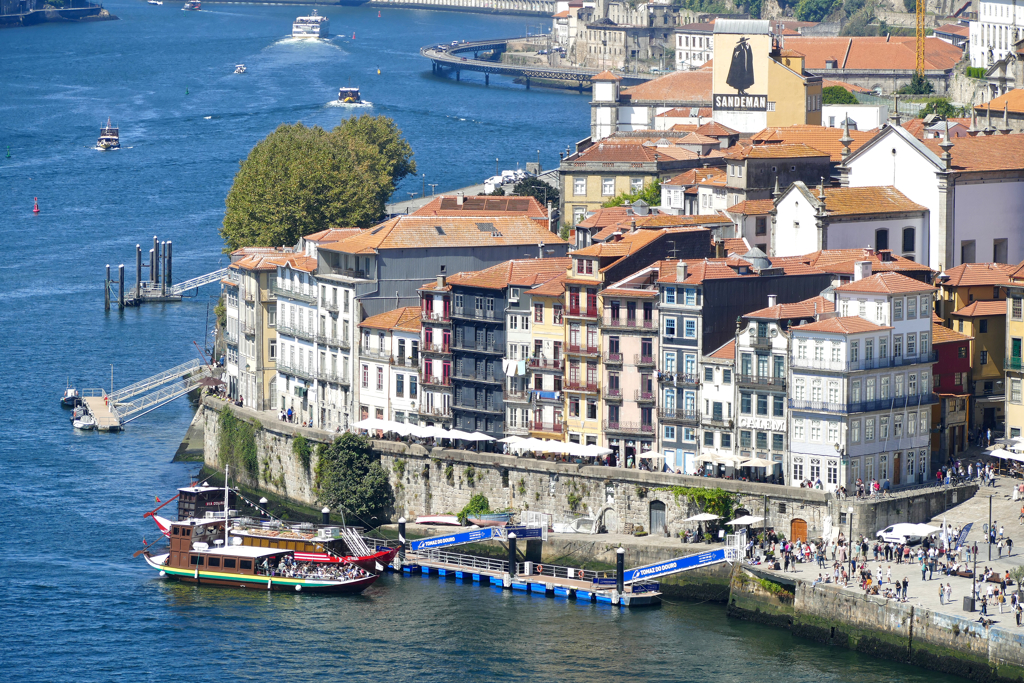
Porto’s development adapted to this challenging terrain, resulting in steep, narrow streets and varied elevations throughout the city. The hills contribute to the city’s charm, offering stunning views over the river and the historic center. Yet, they also make it a challenging place to explore.
My absolutely favorite spot when it comes to panoramic views of the city is the Miradouro da Vitória. Nestled in the heart of Porto’s historic center just a couple of steps from the Igreja dos Clérigos, this viewpoint grants you a sweeping vista of many of the city’s architectural highlights, the Douro River, as well as the colorful hodgepodge of houses on the hillside below your feet.

What makes this place among the many Miradouros so special is its balance of tranquility and stunning scenery. Usually, it’s far less crowded than the other viewpoint so you have a more intimate experience while taking in the beauty of Porto.
Terreiro da Sé
In contrast to the Miradouro da Vitória, the Terreiro da Sé is not an insider tip and certainly not a place if you are looking for serenity. There is probably no visitor who skips this complex towering over the old town of Porto.
Construction of the Sé, hence, Porto’s Cathedral, began in a Romanesque style in the early 12th century. The Gothic cloister was then added in the 14th century. However, the exterior of the cathedral was profoundly redesigned during the Baroque and Rococo periods. In the 18th century, our friend Nicolau Nasoni designed a loggia on the north facade.
Entrance to the cathedral is free, but you have to pay 3 €uros to visit the cloister and the small museum.

Nevertheless, the Terreiro da Sé, as it appears today, is actually a creation of the 1940s. To make way for this spacious square, several medieval structures were demolished. While some buildings such as the Capela dos Alfaiates were dismantled and rebuilt in a different spot, most of the old buildings on the site and even some streets disappeared forever.
South of the Cathedral stands the Episcopal Palace of Porto. While it served as the home of the city’s bishops until the 19th century, it now functions as a cultural venue. Parts have been transformed into a museum. Visitors can explore its ornate interiors, grand halls, and impressive rooms, which are filled with paintings, sculptures, and other religious treasures. Also, its elevated position grants stunning views.
The Episcopal Palace is open to the public from Monday to Saturday from 9 a.m. to 1 p.m. and in the afternoon from 2 p.m. to 6 p.m. for an entrance fee of 5 €uros.
Igreja e Colégio de São Lourenço
Yes, it’s all about the views in this mesmerizing city! And you don’t even have to climb up church towers or other stately buildings. You can enjoy them for free from any of the city’s many Miradouros!
Right in front of the Terreiro da Sé is the Miradouro da Rua das Aldas and just a couple of stairs further below is the next one adjacent to the Igreja de São Lourenço.
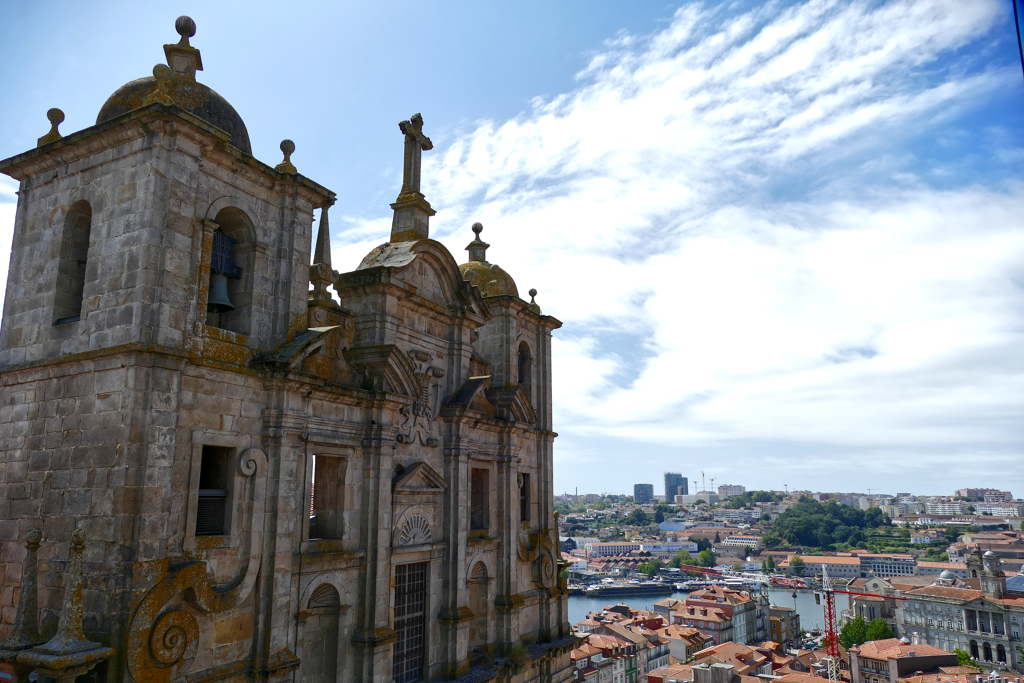
Now, the Church and Convent of São Lourenço is an ambitious project in Mannerist Baroque style commissioned by the Jesuits in 1577. However, in 1759, the Jesuits were shown the door, thanks to the Marquis of Pombal’s orders. Their church ended up in the hands of the University of Coimbra until the Discalced Friars of the Order of Saint Augustine took over in 1780.
But their time in the city was cut short by the Siege of Porto. The friars were forced to flee as liberal troops under Dom Pedro stormed in.
Today, the historic site is in the hands of the Seminário Maior do Porto, where it has been since 1834, continuing its legacy in the heart of the city.
Escadas dos Guindais
I have a few favorite places in Porto, and the Escadas dos Guindais are one of them. This historic and picturesque staircase connects the Batalha neighborhood east of the Sé with the Ribeira, hence, the riverside area. They actually date back to the 12th century, initially built to facilitate access between the upper and lower parts of the city. Whether you go up or down these stairs, you will find it very ironic that they were built for facilitation.

Because of its proximity to the river, the area around the 321 steps was vital for the city’s transport’n’trade. To this date, you’ll feel the very charming and authentic vibe passing by the residents’ homes and small shops despite the steps’ popularity among locals and tourists alike.
Don’t worry, once you come down the stairs, you don’t necessarily have to climb them again as near the Escadas dos Guindais is the Guindais Funicular. This funicular was originally opened in 1891 to assist with the steep incline but closed after an accident. It was rebuilt and reopened in 2004, providing a very comfortable means of transportation up and down the hill.
The lower station of the funicular is right next to the iconic Ponte Dom Luís I which connects Porto to Vila Nova de Gaia.
Crossing the Bridge: Vila Nova de Gaia
In the 18th century, the town on the southern bank of the Douro, which flows into it, developed into a rapidly growing settlement of sailors, craftsmen, and business people as a result of the settlement of foreign traders in the context of port wine production. By the edict of Queen Maria II, Vila Nova de Gaia received city rights in 1841. The extensive halls of the port wine producers, in which the port wine matures for years or decades, are still an important economic factor.
And although Porto opposite is, strictly speaking, more picturesque than Gaia, the south bank has become another tourist magnet. Especially on the promenade along the river, restaurants are lined up and hawkers offer all sorts of souvenirs.
The World of Wine cultural district, or WOW for short, which opened in 2020, contributed to further rush. It consists of seven museums, twelve restaurants, bars, and cafés as well as shops and even a wine school. The complex is open every day from 10 a.m. to 1 a.m., albeit, the museums close already at 7 p.m.
Ponte Dom Luís I
In addition to the Torre dos Clérigos, the Ponte Luís I, which opened in 1886, is the city’s most famous landmark. It is the second oldest of the remaining bridges over the Douro. It was built by Gustave Eiffel’s company and largely designed by his then-partner Théophile Seyrig.
Seyrig later separated from Eiffel and planned the Ponte Luís I for the Belgian company Société de Willebroeck.

The Ponte Luís I has two street levels: the lower level serves traffic between the riverside districts of Ribeira and Cais de Gaia and is bordered by two very narrow sidewalks. The upper level was originally used for traffic between the higher parts of the city. Since 2004, it has been reserved for the Metro do Porto and pedestrians.
In 1877, the Ponte Maria Pia railway bridge was put into operation about one kilometer upstream. It is also a truss arch bridge and is sometimes confused with the Ponte Luís I.
Jardim do Morro
The upper part of the Ponte Dom Luís I ends on the south side of the Douro directly at the Jardim do Morro. This well-kept green area was built in 1927 and is home to a small lake, a bandstand, and a wide variety of plant species.

The real highlight of the garden, however, is the view of the old town of Porto with all the iconic landmarks in sight.

Since 2011, a cable car connects over a distance of 560 meters the Jardim do Morro with Cais de Gaia. The cable car is in operation from 10:00 a.m. and closes, depending on the season, between 6 p.m. and 8 p.m. A one-way ticket for adults costs 7 €uro and a round trip sets you back 10 €uro. A family ticket for two adults and two children costs 22.50 €uro round trip.
Escadas de Cândido Reis
Most people stumble by pure accident over the Escadas de Cândido Reis. These stairs are on the way down from the Jardim do Morro to the Cais de Gaia, hence, Gaia’s riverfront.

As you come down the stairs from the garden, you could easily miss the magnificent, detailed paintings by Belgian artist Jaune. But mostly people stand at the foot of the stairs and delight in the sight of the small neighborhood the artist has created around the steps.


Jonathan Pauwels aka Jaune has been celebrating street workers in his art projects since 2011. He honors their often dismissed yet significant work. His miniature garbage men heroically lead the fight against oversized waste bags and overwhelming trash tsunamis. This way, Jaune charmingly combines humor with subtle social criticism.


By creating with stencils, the self-taught artist achieves an impressive level of detail, which makes his works almost a kind of hidden object picture with many enchanting details.
Jaune’s art can be found in cities around the world, blending seamlessly into urban environments and adding a whimsical yet thoughtful layer to public spaces.
If you want to see more urban art, take a look at my post Best Street Art in Porto.
Square And Fair: The Most Exquisite Praças
Aren’t you getting exhausted? But you’ve actually seen the best of Porto, and we’re slowly coming to the end of the grand tour of the city.
However, you can’t leave Porto without visiting the three most important of the many squares.
Praça da Ribeira Porto
Located alongside the Douro River, Praça da Ribeira has been one of the most iconic and historical squares in Porto for the longest time. Every visitor knows this, therefore, it is one of the city’s most popular tourist spots. The square opens up to the Cais da Ribeira, a lively riverside promenade filled with restaurants, bars, jugglers, and hawkers. And that’s exactly the reason why it is one of Porto’s areas that I like the least.
There’s just way too much going on for me.

Dating back to the Middle Ages, Praça da Ribeira has been a vital part of Porto’s trading activities. Originally, the area around the square was a bustling marketplace where goods from the river were bought and sold. The square is surrounded by traditional colorful, narrow houses that seem to rise precariously along the steep streets.
As part of the city’s UNESCO World Heritage Site, the Praça da Ribeira offers a glimpse into Porto’s rich history and local culture.
Jardim do Infante Dom Henrique
Just a few steps north of the Praça da Ribeira is the Jardim do Infante Dom Henrique. This garden is a peaceful oasis surrounded by significant historical and cultural landmarks. This way, it offers visitors a blend of history, greenery, and architectural beauty.

The garden is named after Infante Dom Henrique, a Portuguese prince from the 15th century who played a key role in the early days of Portuguese exploration’n’exploitation during the Age of Discoveries. His efforts in promoting sea voyages paved the way for Portugal to become a leading colonial power.
Therefore, I have my doubts as to whether visitors from other lands that Portugal had subjugated and exploited as its colonies would celebrate good old Henrique in the same way, but so be it.

The Jardim do Infante Dom Henrique is bordered by several majestic buildings and landmarks that I’ve introduced above such as the Palácio da Bolsa and the Church of São Francisco.
Another striking structure worth mentioning – and visiting, for that matter – is the Mercado Ferreira Borges. This remarkable iron and glass edifice, originally built as a market in the 19th century, now functions as a cultural space, hosting events, exhibitions, and performances. The terrace facing the park is a great place to take a break from walking up and down Porto’s streets and enjoy a refreshment.
Praça da Liberdade
Praça da Liberdade is the most important square in Porto. It is right in the heart of the city.
Its origins date back to the 18th century, when it was originally intended to expand Porto beyond its medieval walls. Over time, the square developed into the city’s most important public meeting place and was an important location for important political and social events.

In the center is an equestrian statue of Dom Pedro IV, King of Portugal and Emperor of Brazil, erected in 1866.
The square is framed by imposing neoclassical and Beaux-Arts buildings that showcase early 20th-century architecture. The majestic facades and ornate details are simply wonderful and make the square worth a visit.
At the northern end is the Câmara Municipal do Porto, Porto’s town hall. Correia da Silva designed the magnificent building, which was completed in 1957. It features a striking bell tower that is 70 meters high.

Another architectural highlight at Praça da Liberdade is the Bank of Portugal building. Designed in a neoclassical style, this building features a stone facade with columns and large arched windows.
However, Praça da Liberdade is not only a cradle of architectural gems, but also a vibrant social and cultural space. The square often hosts public events, celebrations, and festivals, making it a vibrant part of Porto’s daily life.
Practical Information
How to Get There
By Plane
Aeroporto Francisco Sá Carneiro Airport is certainly not the most important hub in Europe. But it is, after all, one of only three international airports in Portugal and is the second largest in the country after Lisbon, obviously. It mainly serves European, but also some transatlantic flights.

The airport is located almost 15 kilometers northwest of the city center. To get downtown, you don’t need to take a cab unless you have extremely bulky and heavy luggage. There are bus connections and, above all, the purple metro line E takes you there quickly and reliably for an incredible 1.40 euros!
By Train
Travelling by train in Portugal is an eco-friendly choice, reducing your carbon footprint compared to car or plane travel. But train travel is also a scenic way to explore the country, offering comfort, efficiency, and affordable prices. The rail network is very well-developed and reliable.
The train ride between Lisbon and Porto is known for its scenic views, especially as the tracks pass through coastal areas, rural villages, and beautiful green landscapes. You’ll get to see a blend of countryside and urban views, with occasional glimpses of the Atlantic Ocean along the way.
There are various types of trains with the so-called Alfa Pendular being the fastest and most comfortable one. It offers free Wi-Fi, air conditioning, and onboard snack service. It gets from Lisbon to Porto in less than three hours. The so-called Intercidades are slightly slower, however, they are more budget-friendly but still offer comfortable seating and amenities.
Note that discounts are available for advance bookings, seniors, students, and young people under 25. Booking tickets online via the Comboios de Portugal’s website is highly recommended.
Trains usually arrive at Porto’s main station Campanhã Station. From there, you can easily reach the city center by metro. However, some trains also continue to the more central São Bento Station
By Bus
Traveling by bus in Portugal is a convenient and far more affordable option. Buses connect major cities like Lisbon, Porto, Faro, and even many smaller towns that may not be accessible by train.
Portugal’s main long-distance bus companies Rede Expressos, FlixBus, Renex, and CitiExpress offer reliable and comfortable service. To give you an idea, the bus trip from Lisbon to Porto typically takes around 3 to 4 hours, depending on the service and traffic conditions. A one-way ticket from Lisbon to Porto ranges from 10 to 25 €uros, depending on the bus company, how early you book, and whether it’s a peak travel time.
The highway from Lisbon to Porto is the main route and offers a smooth ride, though less coastal than the train. Although not as scenic as the train ride, the bus journey still offers pleasant views of Portugal’s countryside, passing through small towns, farmlands, and rolling hills.
Buses generally arrive at Porto’s Campanhã Bus Station or the Porto Garagem Atlantico Station. Both terminals are located near the city center which you can then access by metro.
How to Get Around
There is a comprehensive bus network in Porto that also connects the suburbs with the city center. A ticket purchased on the bus costs 2 €uro. If you pay with the credit on a so-called Andante card, within the downtown area each trip is discounted to 1.20€.
In addition to buses, there is also the Metro, an over- and underground light rail system. Here, the one-way trip only costs 1.40 €uro.
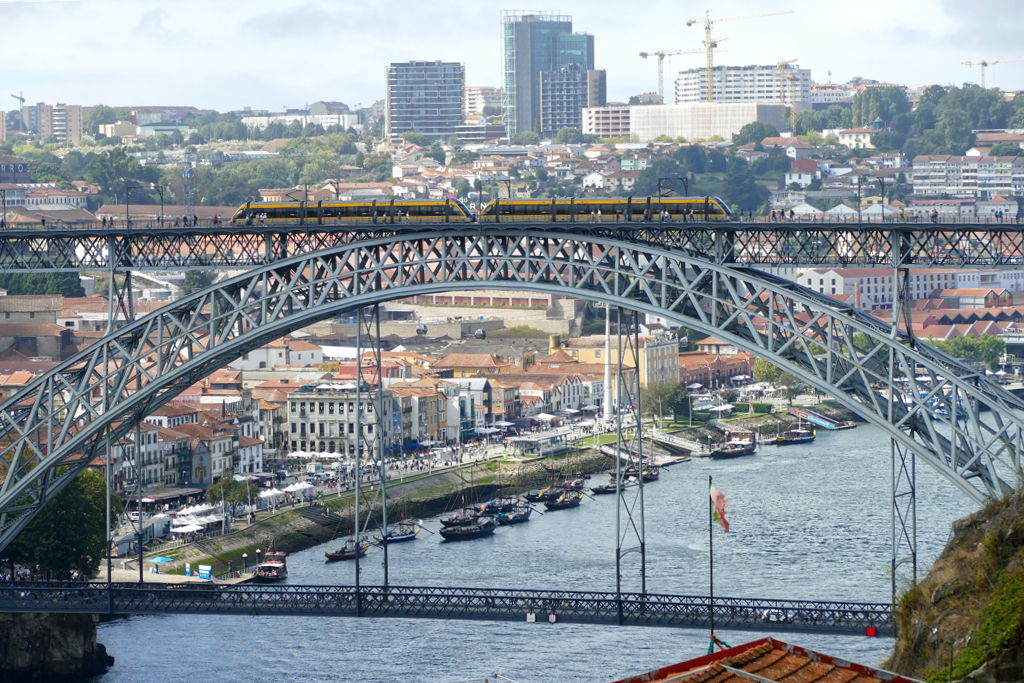
For visitors, however, there are two kinds of day passes. Firstly, there is the Porto.CARD which grants free public transportation for a designated period of time. In addition, this card includes further perks and savings.
Nevertheless, if you’re not planning on visiting chargeable attractions and landmarks, the so-called Andante Tour Card might be sufficient. Depending on the length of your stay, you can purchase an Andante Tour 1, which is valid for 24 hours from first use and costs 7 €uro. Or you choose an Andante Tour 3, valid for 72 hours at 15 €uro. Unlike the usual Andante Card that the locals use, the Andante Tour Card expires and is not rechargeable.
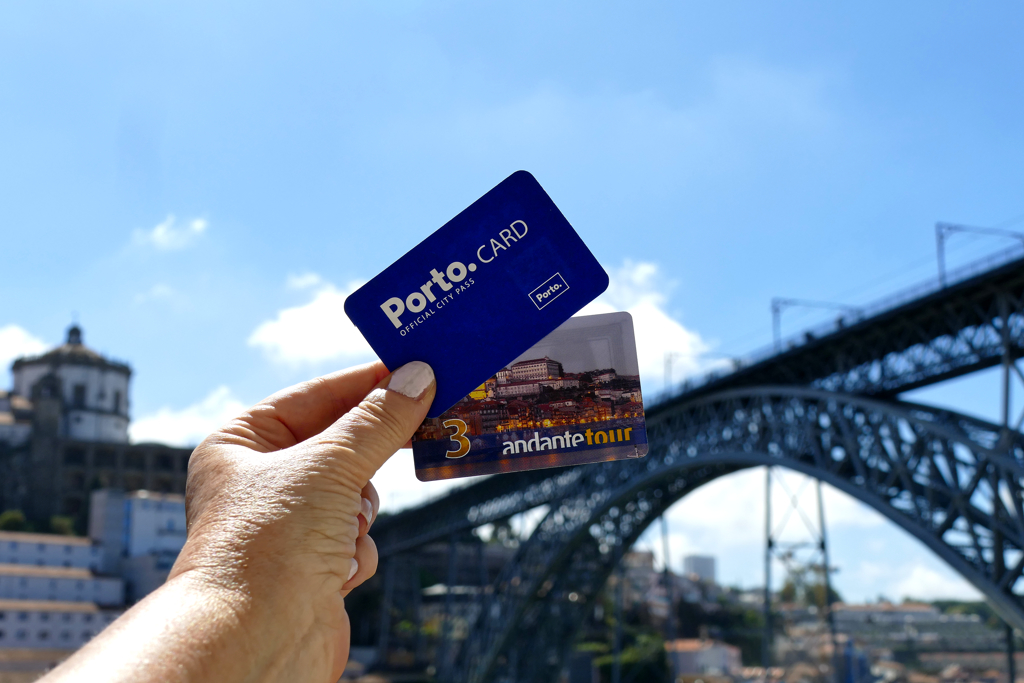
Three tram lines still operate in Porto. However, because of the high price, they are intended more as a tourist attraction. In particular, the trip along the Douro on line 1 from Rua do Infante Dom Henrique to Jardim do Passeio Alegre is a very scenic ride.
Walking And Cycling
Porto’s center is relatively small and you can walk to most attractions. Within the very center, this is often even quicker than waiting for the bus, especially since the stops are sometimes so inconveniently located that you have to walk a long way, anyway.

Yet, as short as the routes within Porto are, they can be strenuous. The city is very hilly and you are constantly climbing up and down steep streets and alleys on uneven, extremely narrow sidewalks that are covered with cobblestones. A walk through Porto is definitely more of a sporting challenge than a relaxed stroll.
And that should also answer the question of whether cycling is a valid alternative in Porto. Of course, you can ride on straight stretches along the Douro River and on some main roads. But as a means of transport to explore the city, I think riding a bike is quite adventurous.
Where to Sleep
The Renaissance Porto Lapa Hotel* – honestly, I don’t even know where to start. At the inviting reception, where friendly receptionists stand at small desks instead of behind an unwelcoming wooden counter? Where you can sink into a comfortable armchair and leaf through one of the stylish coffee table books.

Or you can immediately go up to your noise-proof room, where you will find furnishings reminiscent of the color scheme of the 1940s: some in petrol green, in contrast, a chaise longue in old pink. All metal parts in matt old gold and curved in the Art Deco style.

I immediately slip into one of the plush bathrobes and press a pod into the small coffee machine. While it quietly gurgles an espresso, I dig a swimsuit out of my suitcase. On the roof, you have a lounge area with a bar and – most importantly – an infinity pool. A dip in the heated pool and a small snack with a view of the city and the Atlantic beyond refreshes me and I am ready to explore this fantastic city.
Get Ready
After a particularly good night’s sleep on a bed with a comfortable, firm mattress, it’s hard to get up, but I know that there’s an incredible buffet downstairs with a huge selection of fresh, delicious, healthy treats.
Wait for me, I’m coming!

I take some of the freshly sliced fruit and am then spoiled for choice as to which egg dish to choose. The poached eggs on a bed of spicy tomato puree look very tempting. Plus a few slices of salmon and a small bowl of a fine vegetable salad. Let’s see if there’s still room for the pillow-thick pancakes afterward.

The orange juice is freshly squeezed and the coffee is black and strong – what more do you need for the perfect start to the day?
Don’t Spoil the Ship For a Ha’pworth of Tar
I often said to myself, why should I spend more money than necessary on a hotel on a city trip? I’m only there to sleep anyway. You live, you learn. Could it be that I was only there to sleep because there was nothing else tempting that would have lured me back early from a long, exhausting day downtown? Probably. It’s a great feeling to know that a tastefully decorated room is waiting to pamper my senses. Also, I can stretch out on a comfortable lounger above the rooftops of the city, a charming pool boy brings me a glass of deep-red Porto, and I can end a wonderful day appropriately.

If you then add the convenience that the Renaissance Porto Lapa Hotel* is on the E metro line, which goes from the airport to the city center, there can really be no argument against a stay in this affordable 5-star hotel.

For me, in any case, no other hotel in Porto comes into question than the Renaissance Porto Lapa Hotel*
Nevertheless, if they should be booked out or if you prefer to stay in a different area, here are some more lodging options*:
However, if you prefer to stay on the other bank of the river Douro in Vila Nova de Gaia, I’d recommend the very comfortable yet reasonably priced Hotel Mercure Porto Gaia* where I stayed on a former trip.
What to Eat
Although I ate more than my fill at the breakfast buffet – unfortunately I couldn’t eat the pancakes after all – I was hungry again by the afternoon at the latest. This is of course not a disaster in a city like Porto. Luckily, Porto’s staple dish, the Francesinha, is something for the really hungry. It’s a massive sandwich filled with layers of cured meats like ham, linguiça, and steak – yes, not or but and. This tower of bread and meats is then packed in melting cheese and drenched in a spicy beer and tomato-based sauce. It’s often served with a fried egg on top.


I’m one of those people who like things typical and traditional. It’s not always tasty. When I order grayish steak and kidney pie with mash and liquor in London, I don’t do it because I like it, but because it’s authentic.
And I have to admit that I feel the same way about the Francesinha. I’ve just never had a really good one. It’s not helpful that every local has a sure tip as to where the Francesinha is best. The concept of this dish doesn’t make sense to me. And so I heroically eat a Francesinha every time I’m in Porto and will probably never really enjoy it.
There’s More
Adventurous foodies will find other quirky dishes like Tripas à Moda do Porto. It is a stew made with tripe, hence, cow’s stomach, beans, sausages, and vegetables. Porto is historically linked to this dish, and the locals even refer to themselves as Tripeiros, hence, tripe-eaters.
However, also typical of northern Portugal are Rojões, small chunks of marinated, fried pork which is served with side dishes like potatoes, rice, or stewed vegetables.
As you probably know, Portugal is known for its bacalhau which is salted cod. A popular version in Porto is Bacalhau à Gomes de Sá. It’s flaked cod, potatoes, onions, hard-boiled eggs, and olives baked together. Or you have bacalhau as so-called Petiscos. Those are small snacks similar to Spanish tapas. As we’re on it, if you’re a fan of fish and seafood, try Polvo à Lagareiro. That’s a dish made from baked octopus served with generous amounts of olive oil, garlic, and potatoes.

No visit to Portugal would be complete without Pastel de Nata, the famous custard tart. Although it’s more commonly associated with Belém on the outskirts of Lisbon, Porto’s bakeries still serve some excellent versions.
And last but not least, you cannot leave Porto without having tried some Port wine for instance on a guided tour to the cellars of Vila Nova de Gaia. Some of the most popular port houses are Graham’s, Sandeman’s, and Taylor’s which offer excellent tours and tastings of their various port styles such as ruby, tawny, and vintage.
What to See
I’m an avid solo-travelling woman. Since solo-travel doesn’t equal solitude, I love to join organized tours here and there. They allow me to meet fellow travellers – for just a short moment or a lifelong friendship.
Therefore, here are some great ideas of what to do when visiting Porto. Especially during the high season and public holidays such as Easter, pre-booking online will guarantee your spot at the activity of your choice*:
Cash, Cards, And Discounts
Until now, 20 European countries replaced their former local currency with the €uro starting in 2002. Obviously, Portugal is one of them. The exchange rate is 1 US$ = 0.92 EUR as of November 2024. However, you can check today’s conversion rate on this page.

Cards are accepted basically everywhere. Except, of course, at the small stands on the streets and at the market.
Entrance fees in Porto aren’t exactly neck-cutting, but it’s still worth saving a little here and there. And that’s where the Porto.CARD comes into the picture. It is the official sightseeing pass of the city of Porto. Just like the Andante Tour Card, it offers free and unlimited use
of public transport. However, Porto’s historic trams are not included as they are rather a tourist attraction than a means of transportation.
Also, other than the Andante Tour Card, the Porto.CARD grants free access to five museums that are closely linked to the history of the city and are not on every tourist’s itinerary. I think it’s a good opportunity to get to know lesser-known sites in Porto. And even if you want to follow the more well-trod tourist path, the Porto.CARD will be very useful as it gives you up to 50 percent discount with a total of 150 partners!
You can buy the Porto.CARD already before your trip to Porto online. This way, you can use the metro to the city center for free right after arriving at the airport of Porto!
| 24 hours | 48 hours | 72 hours | 96 hours | |
| Porto.CARD | 15 €uros | 27 €uros | 32 €uros | 41.50 €uros |
| Andante Tour | 7.50 €uros | 16 €uros |
Language
Did you know that Portuguese is the fifth most spoken language in the world? It is the official language in Brazil, Angola, Cape Verde, Guinea-Bissau, Mozambique, São Tomé and Príncipe, East Timor, and Portugal, obviously. In addition, Portuguese is spoken both in Macau, which was under Portuguese administration until 1999, and in Goa. What I find all the more surprising is how few visitors speak the language – compared to, for example, Spanish.
Speaking of which, if you speak Spanish reasonably well, you’ll be able to at least read Portuguese quite easily, and if Portuguese speak slowly and clearly, you’ll understand a lot, too. It’s a problem with speaking, because although Spanish – and Italian, and to a certain extent also French – and Portuguese are similar, they definitely are different languages. You shouldn’t assume that everyone will understand you if you just babble on in Spanish for the sake of simplicity. Furthermore, this is not very much appreciated and often perceived as rude. If you want to use Spanish, at least ask at the beginning of the conversation if that would be okay.
I would also like to emphasize how many Portuguese – especially young people, of course – have an excellent command of the English language. Nevertheless, it is a gesture of respect to learn some basic vocabulary, and today this can be done quickly and easily with the help of language apps like Lingohut or Babbel.
Connection and Communication
Since June 2017, no roaming charges have applied within the EU with a European mobile phone contract. This applies to all 27 countries of the European Union as well as Iceland, Liechtenstein, and Norway. It pertains to all contracts.

When roaming is not available, you can connect to the internet in many public places free of charge.
You can get a SIM card if you insist on being online 24/7. For example, cards by LycaMobile start at 10 €uros. However, although the plan lasts for 30 days, keep in mind that it only includes 4 GB of data. Other recommendable providers are MEO, NOS, and Vodafone.
In Portugal, they use plug types C and F. Their voltage is 230 V and the frequency 50 Hz. Nowadays, as all these chargers have integrated adapters, in general, the voltage and frequency don’t really matter.
By the way, you’ll find comprehensive travel info in my post World’s Most Complete Travel Information – an indispensable globetrotter-classic.
Map
For better orientation, here is a map with all the wonderful spots listed in this post.
Clicking on the slider symbol at the top left or the full-screen icon at the top right will display the whole map including the legend.
Porto was only the first of many beautiful places I’ve visited in Portugal. To read about the others, go to the main post and take your pick! There you’ll also find valuable general information that will make your trip smoother.
Pinnable Pictures
If you choose to pin this post for later, please use one of these pictures:

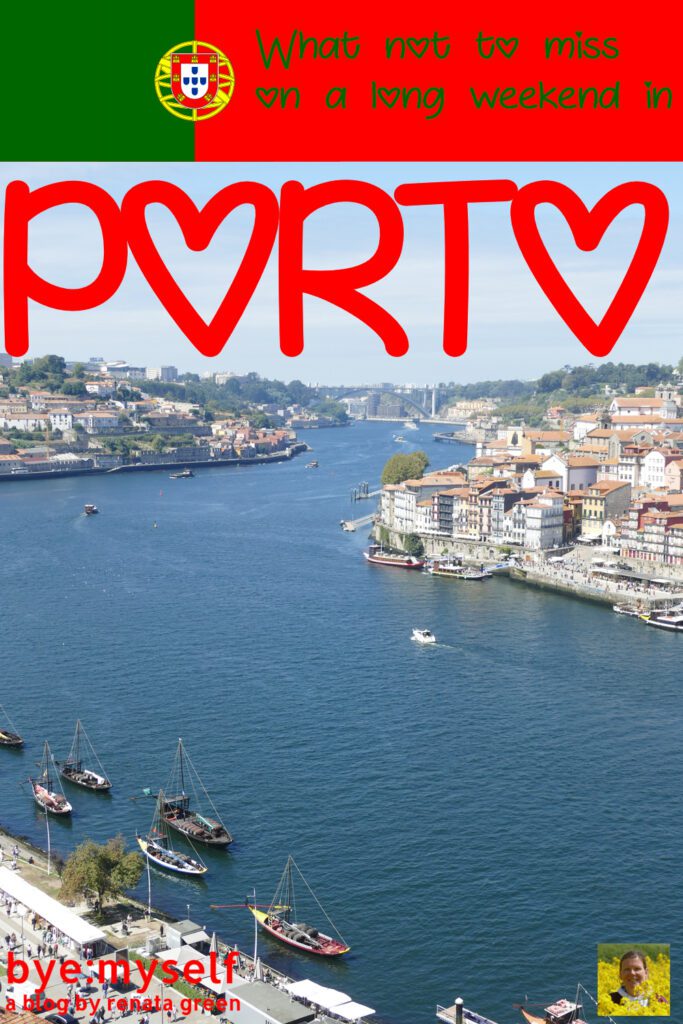
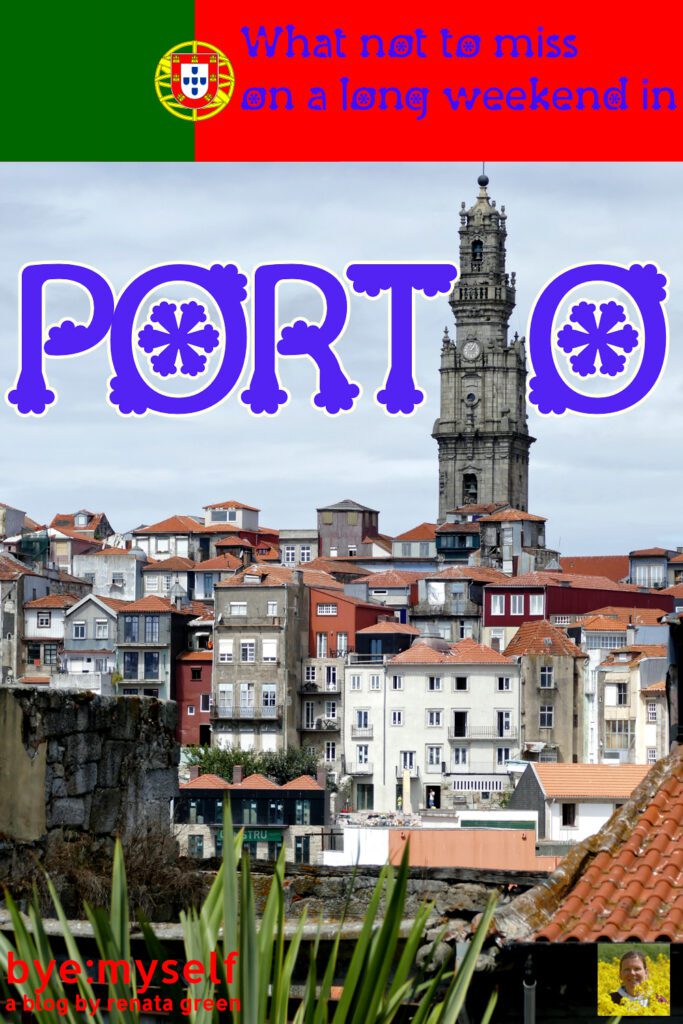
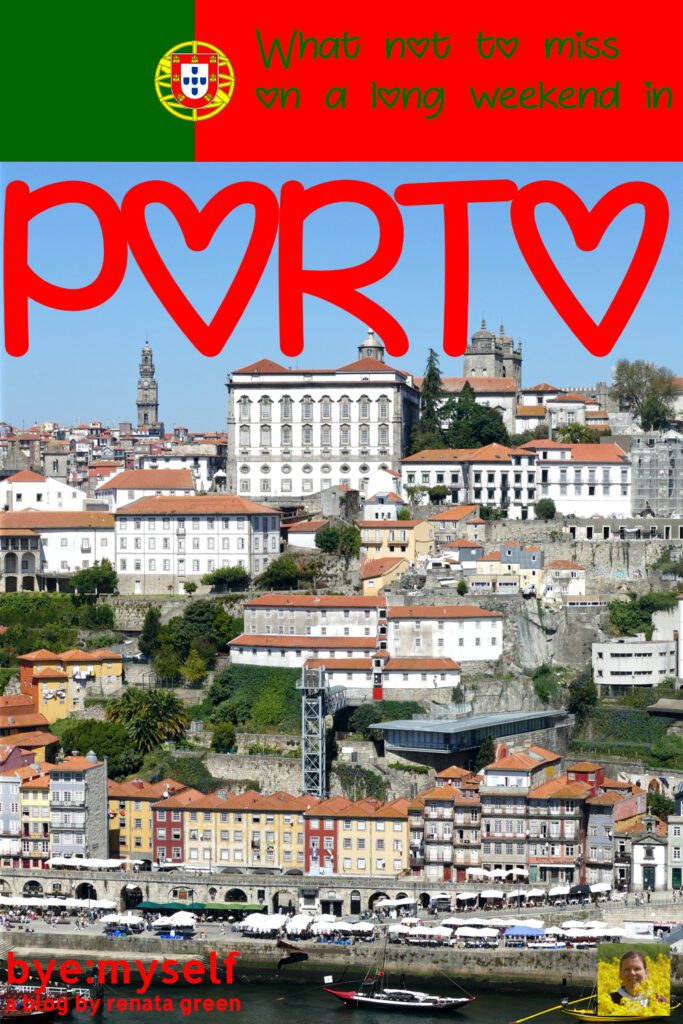
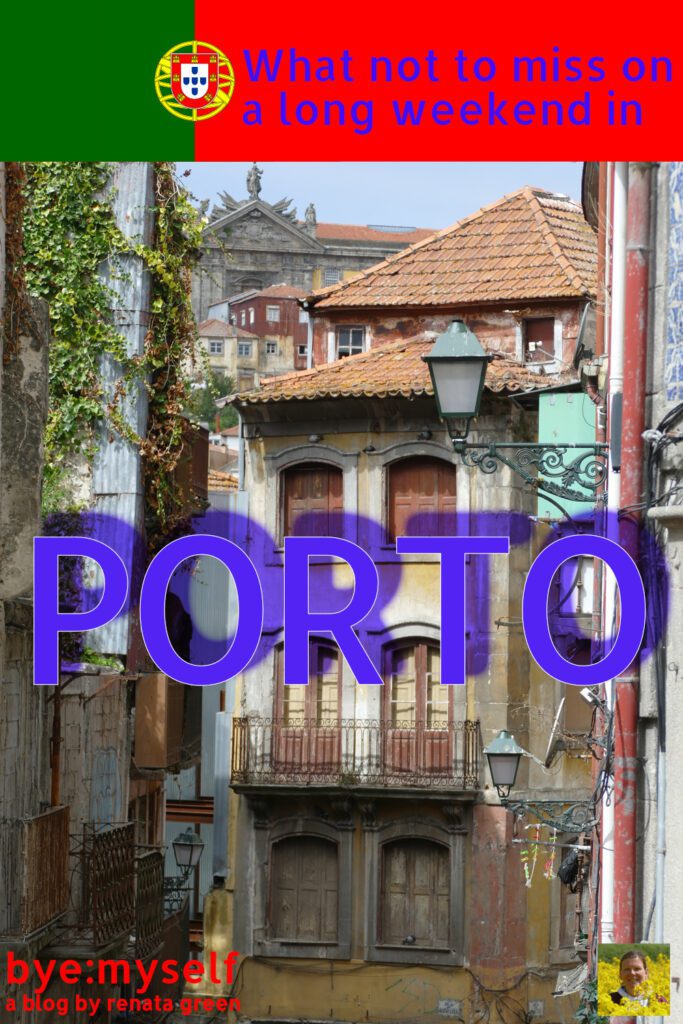

Note: I’m completing, editing, and updating this post regularly – last in November 2024.
Did You Enjoy This Post? Then You Might Like Also These:
FAIAL – the Most Beautiful Island of the Azores
Best Street Art in PORTO
Guide to BELÉM – Lisbon’s Treasure Box
Guide to FIGUEIRA da FOZ – a Charmingly Old Fashioned Seaside Resort
Guide to COIMBRA. On the Beauty of Knowledge
Best Street Art in LISBON – Part III: Moscavide
PICO – the Top of the Azores
Best of LISBON – also for solo-travellers
Disclaimer: I was invited to stay at the Renaissance Porto Lapa Hotel as well as at the Hotel Mercure Porto Gaia on a former trip. Also, Turismo do Porto e Norte de Portugal supported my blogger trip by supplying me with a 72-hour Porto Card. However, all opinions on these services are mine and weren’t by any means influenced by my cooperation partner.
*This is an affiliate link. If you book through this page, not only do you get the best deal. I also get a small commission that helps me run this blog. Thank you so much for supporting me!








Remarkable piece of content! 👏 This is definitely going in my bookmarks!
Thank you for your kind words!
Your blog has quickly become one of my favorites. Your guides are so insightful, your posts always keep me inspired. Keep up the phenomenal work!
Thank you for your kind words – I’m always here to help 🙂 Happy travels!
Thank you for your sharing. I am worried that I lack creative ideas to put together my own itinerary so your post is very helpful. But, I have a question, can you help me?
Of course. You can add it here or you send me a PM.
Great Post ! I have read your other posts which are really informative for any traveler. Thanks for sharing such a beautiful informative information on the blog. Articles that have meaningful and insightful content are so enjoyable!
Thank you for your kind words!
We are a group of volunteers and starting a new scheme in our community.
Your website offered us valuable info to work on. You’ve done an impressive job and our entire community will be grateful to you.
So glad I was able to help – good luck with all your endeavors 🙂
Porto looks gorgeous! Can’t wait to see it on a Europe trip next year!
Love seeing all the historic places to visit! We loved seeing the basilica in Florence so the church you mentioned here and climbing to the top will be worth the climb!
Have heard a lot of good things about Porto, but have never been. This was a virtual travel for me through your post 🙂 . Loved the story of the singing man on his balcony.
Yes, he definitely added to the charm 😀
I really enjoy looking this place. this is looking so amazing thing.
Wow! Portugal is indeed a lovely place! It’s the first time that I have heard about Porto! Love all of the art designs everywhere.
Porto looks so amazing. I would love to visit all of the fabulous landmarks there. I just love the art and architecture of this area!
Porto looks like a beautiful city Renata – I particularly loved all of those blue tiles which are gorgeous. The city wasn’t on my radar before reading this – now I’d love to visit.
Yes, I think it’s still quite underrated.
Porto is such a beautiful city! I can’t wait to visit again once this pandemic is over!
You and me both, sister 🙂
Fabulous, what a blog it is! This weblog gives useful information to us, keep it up.
Thank you, so glad you appreciate my work 🙂
Oh wow! What a gorgeous place! The wall murals in the train station and that awesome magical Livraria Lello. I would love to spend a few hours in there. Thanks for sharing so many hidden gems in this place.
Yes, Porto is definitely very enjoyable 🙂
What a great thorough review of Porto. We loved visiting and your post brought back such great memories. I am glad you did not pass on Porto. We saw a lot of churches on the inside. But are now sorry we missed going inside the Palacio da Bolsa. I can certainly see that the design was influenced by the Moors. We loved all the food in Portugal although I must admit I never did really get into the Francezinha sandwiches. I can’t wait until we can get back to Portugal.
Linda, I’m so happy you enjoyed Porto as much as I did. Next time, you have to visit the Bolsa – it’s pretty amazing!
I love exploring a new city on foot. There’s no better way to get a feel for a place than just wandering off the beaten path, down back lanes, and little alleys. It looks like Porto is my kind of city.
Me too. But also cycling. But that’s a drag at hilly cities like Porto 😉
You have covered Porto in great depth, all the destinations you mentioned seem worth exploring! I visited Lisbon and the coastal areas of Portugal, Albufeira and Algarve. You description of Porto makes me wonder why I missed it lol! Esp for the wine and the shop scene you described. Also the magic staircase does seem like a find, wasn’t aware of the Harry Potter connection. Enjoyed the read 🙂
I think it’s because it seems so far – way up north. However, it was only four hours by train. I initially wanted to skip it,too – and then I was sooo happy that I didn’t.
You know I had a trip planned to Portugal this summer and I had not put Porto in my itinerary but I am so glad the trip didn’t happen this year. Your post convinced me why I need to visit Porto. Just like you, I too love hidden gems within the big gem. So, thanks for convincing me to explore all of these gems on my next trip.
That’s the spirit: Look at the bright side 😉 Yes, I definitely wouldn’t skip Porto – it has a very nice vibe to it. Happy travels – once it’s possible again 😀
Love Porto, one of my fave places to visit in Portugal. Never did manage to get inside the Livraria Lello, the queue was always so long, maybe not so bad now.
Have to agree with you on the franceschina – really cant see what the fuss is about!
Sometimes it’s rather the myth. I also ate some really bad food in London just because it’s a “national treasure” – faith of the curious traveller 😀
I’m really enjoying the design and layout of your site.
It’s a very easy on the eyes which makes it much more enjoyable for me to come here and visit
more often.
Your articles are always so in depth! I have to admit I have never taken a train road trip, but it is a good idea. I need to add Porto to my must-see list!
Thank you, Laurel. Yes, like you should make gifts you’d like to keep for yourself, I write for others what I would like to read 😉
You have covered the trip with so much details, very helpful. I like churches, museums so obviously added Porto to my bucket list. Wonderful pictures. The landscape looks great
You will love it – it has a great atmosphere.
I have never been to Porto but I do hope to visit it soon enough. I think it’s a lovely destination
I loved it there and would like to go back asap.
I have been to Portugal a number of times but never to Porto & I have to admit that it has never really been on my radar. However, you have just sold me! It looks beautiful & definitely somewhere I would enjoy wandering around. Thank you for highlighting…yet another gorgeous location to add to my list 😉
I totally understand – somehow it stands in the shadow of Lisbon. But actually for no valid reason – hence, I tried to shine some light on it 😉
Aw, this was an exceptionally nice post. Taking the time
and actual effort to create a superb article.
This city has been on my bucketlist for quite some time now, not really on the top but still … you article looks amazing and that staircase seems taket straight out of Harry Potter 😀
I believe that Porto stands a bit in the shadow of Lisbon – though it has so much to offer.
A great indepth guide of what to expect in Porto. I visited last year and like you found the frascinha very overpowering and rich! i loved doing tours of the wine cellars interesting as well as tasty!
Yes, the Francesinha is rather a challenge than a meal 😀
I haven’t been to Porto yet either. Along with travel texts, I always like to look at pictures and all the moments that are captured in photos. Porto is definitely worth a visit.
Thank you so much for your feedback! Good to know – I often wonder if my readers need so many pix before seeing the places in person.
I really like what you guys are usually up too.
This sort of clever work and coverage! Keep up the awesome works guys I’ve incorporated you guys to my blogroll.
Wow looks like a wonderful place with magnificent buildings. I would love to visit Porto. Thanks for the detailed information.
It’s totally worth the visit.
Porto seems like an amazing place to be and in a way, it does seem similar to Venice when it comes to humid climate. A very detailed post this is. Thanks for sharing.
Hm, I’ve never thought of it that way. I actually couldn’t compare it to any other city I’ve visited.
I love visiting new places! Thanks for sharing such a detailed tour of Porto!! Truly is a lovely place 🙂
It’s absolutely amazing!
This info is priceless. Thank you for sharing all those valuable tips on Porto!
You’re very welcome!
I would love to visit Porto – it’s been on my list for so long. I also love to find hidden gems in cities that I’m visiting, I find them to be less crowded and a lot more enjoyable than some of the more popular areas. I would be heading to Palácio da Bolsa first definitely!